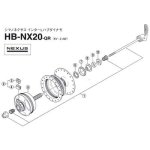SamTexas
1 MW
Hello all,
There is absolutely no practical/economical gain from this discussion. I just want to pick your brain for the sake of learning and tinkering.

How do I turn a hub dynamo into a hub motor? I have a Shimano HB-NX20 hub dynamo in my front wheel. I rarely every use the head light because I ride mostly in daylight. In use or not, it always generates some drag (probably around 2 watts). So instead of letting it rob me of my precious power, I would like to turn the situation around, applying some battery power to it to make it a motor. I know it's more complicated than that and that's why I'm here.
Thanks and happy New Year.
Sam
There is absolutely no practical/economical gain from this discussion. I just want to pick your brain for the sake of learning and tinkering.

How do I turn a hub dynamo into a hub motor? I have a Shimano HB-NX20 hub dynamo in my front wheel. I rarely every use the head light because I ride mostly in daylight. In use or not, it always generates some drag (probably around 2 watts). So instead of letting it rob me of my precious power, I would like to turn the situation around, applying some battery power to it to make it a motor. I know it's more complicated than that and that's why I'm here.
Thanks and happy New Year.
Sam


